Add this eBook to your basket to receive access to all 554 records. Our indexes include entries for the spelling wingfield. In the period you have requested, we have the following 554 records (displaying 491 to 500): These sample scans are from the original record. You will get scans of the full pages or articles where the surname you searched for has been found. Your web browser may prevent the sample windows from opening; in this case please change your browser settings to allow pop-up windows from this site. Long-Lost Relatives: Home Inquiries
(1900)
Each issue of Lloyd's Weekly News, of London, contained a column devoted to searches for Long-Lost Relatives. The inquiries were arranged in three groups: Home Inquiries (i. e., from correspondents in the United Kingdom); Colonial and Foreign Inquiries (from abroad); and Soldiers' and Sailors' Inquiries. Results from all these were grouped together as 'Answers to Inquiries'.
Each column was headed: 'Correspondents MUST give full addresses and the DATES OF THE INQUIRIES to which they refer. We cannot search back numbers, nor print inquiries for "missing husbands." These columns are not intended for inquiries in respect to claimants for money, and no agents, at home or abroad, have any connection with Lloyd's.' | Sample scan, click to enlarge

| Missing Next-of-Kin and Heirs-at-Law
(1900)
The Unclaimed Money Registry and Next-of-Kin Advertisement Office of F. H. Dougal & Co., on the Strand in London, published a comprehensive 'Index to Advertisements for Next of Kin, Heirs at Law, Legatees, &c., &c., who have been Advertised for to Claim Money and Property in Great Britain and all Parts of the World; also Annuitants, Shareholders, Intestates, Testators, Missing Friends, Creditors or their Representatives, Claimants, Unclaimed and Reclaimed Dividends and Stock, Citations, Administrations, Rewards for Certificates, Wills, Advertisements, &c., Claims, Unclaimed Balances, Packages, Addresses, Parish Clerks' Notices, Foreign Intestates, &c., &c.' The original list was compiled about 1880, but from materials dating back even into the 18th century: most of the references belong to 1850 to 1880. For each entry only a name is given, sometimes with a placename added in brackets: there may be a reference number, but there is no key by which the original advertisement may be traced. The enquirer of the time had to remit £1 for a 'Full and Authentic Copy of the Original Advertisement, together with name and date of newspaper in which the same appeared'. This appendix to the list was issued in about 1900. | Sample scan, click to enlarge

|  Outstanding soldiers of the 4th (Royal Irish) Dragoon Guards
(1881-1901) Outstanding soldiers of the 4th (Royal Irish) Dragoon Guards
(1881-1901)
Each year the best soldiers of the regiment were chosen for long service and good conduct medals. This register gives rank, name, regimental number, and date of recommendation. (The sample scan is from the East Surrey regiment). The register is essentially a register of recommendations, annotated with details of the issue of the medals. Where no gratuity accompanied the medal, the entry is marked 'W. G.' (without gratuity); where, for one reason or another, the medal was not issued, the entry is marked 'N. S.' (not sanctioned) and struck through. The regiment was sent out to join in the Egypt campaign of 1882, taking part in the battle of Tel-el-Kebir, adding these to the regimental honours. The troops returned from Egypt in 1882, and in 1885 the regiment was at Brighton, but a detachment had been sent back to the Nile for 1884-5. In 1886 the regiment was moved to Ireland, and back to England in 1891, embarking for India 7 September 1893. The regimental depot was at Shorncliffe; by 1895 the troops were based at Rawul Pindee in Bengal. | Sample scan, click to enlarge
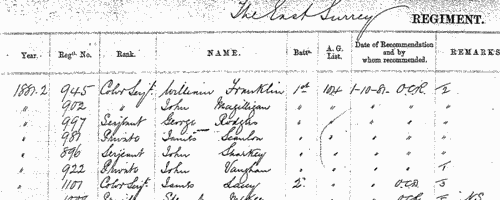
|  British artillerymen fighting in South Africa
(1899-1902) British artillerymen fighting in South Africa
(1899-1902)
The Queen Victoria's South Africa Medal was awarded (after her death, in the event) to all who had served honourably in the various campaigns in the Boer War. Returns were made from each unit, and consolidated into nominal roll, of which this is the one for the Royal Artillery. Confusingly, the ledgers used had originally been printed for a register of men transferred (or re-transferred after mobilization) to 1st Class Army Reserve. All the original column headings were therefore struck through, and the roll was prepared with this information: Date of Issue; Regimental Number; Rank; Name; Unit; Medal (a 1 indicating that a medal was awarded); [number of] Clasps; the reference to the source in the original returns, usually starting with AG for papers in the hands of the Adjutant-General, and 68/Art/ for the Royal Artillery records. The final column, normally left blank, was occasionally used for explanatory remarks. | Sample scan, click to enlarge

| Indian Civil Servants
(1904)
The India List and India Office List was compiled from official records by direction of the Secretary of State for India in Council, and published by the India Office annually. The volume for 1905 includes this Record of Services, corrected to 1 July 1904. It includes Officers of the Home Establishment of the Secretary of State, Officers of the Covenanted Civil Service, and those appointed under the Native Civil Service Rules, other Officers in Civil Employment in India whose substantive pay was at least 1000 rupees a month, and, with a few exceptions, all officers of those classes who had retired since 1886. | Sample scan, click to enlarge

| Members of the Institution of Civil Engineers
(1904)
The Institution of Civil Engineers was established 2 January 1818, and incorporated by royal charter 3 June 1828. The annual report lists the names and addresses (throughout the world) of the four classes of member - members (M. Inst. C. E.), associate members (Assoc. M. Inst. C. E.), associates (Assoc. Inst. C. E.), students (Stud. Inst. C. E.) - with the dates of admission. This is the index to the Members, which also gives dates of transfer from other grades. The symbols at the left of each page are * for Former Students, + for contributors of papers published in the Minutes of Proceedings, or of an Engineering Conference Note; F for a deliverer of a James Forrest Lecture; L for a deliverer of one of the Special Series of Lectures; and various letters for recipients of certain medals and prizes - B, Bayliss Prize; C, Crampton Prize; f, James Forrest Medal; H, Howard Quinquennial Prize; J, Joule Medal; M, Miller Scholarship; m, Miller Prize; italic m, Manby Premium; S, George Stephenson Medal or Prize; T, Telford Premium; t, Telford Premium; italic t, Trevithick Premium; and W, Watt Medal. | Sample scan, click to enlarge
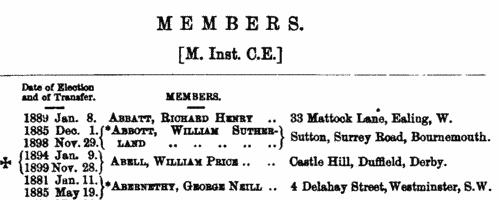
| The India Office
(1905)
The India List and India Office List was compiled from official records by direction of the Secretary of State for India in Council, and published by the India Office annually. It covers civil servants and military except for officers drawing substantive pay of less than 500 rupees a month. Names shown in italics are those of officers in foreign service, supernumerary, seconded or employed outside their own departments. This is the list for the Office of the Secretary of State for India in Council, including the Council, Correspondence Departments, Accountant-General's Department, Funds Department, Store Department, Registry and Record Department, Miscellaneous Appointments, India Audit Office, and Office Keepers and Messengers. | Sample scan, click to enlarge

| Civil Servants and Office Holders
(1907)
The Imperial Calendar gives lists of officials and office-holders throughout England, Wales, Scotland and Ireland
| Sample scan, click to enlarge
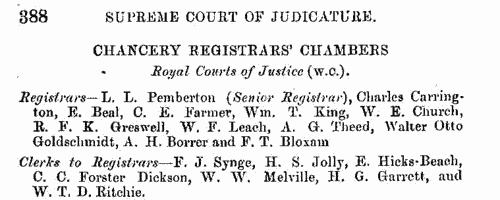
| Boys entering Aldenham School
(1909)
Aldenham School in Hertfordshire is a public school originating as an Elizabethan grammar school. The Aldenham School Register was first published in 1898, but this tenth edition, by R. J. Evans, and published in 1969, comprised only living old boys who had entered the school from 1900 onwards, together with those who had entered the school before 1900 and who had responded to a questionnaire. There is thus a general presumption that all the boys mentioned were alive in 1969. The boys are listed alphabetically by surname under the term in which they entered the school. Full name is given, in bold, surname first. Then an abbreviation indicating their house (B, Beevor's; K, Kennedy's; M, McGill's; P, Paull's; SH, School House); the period of stay at the school; address as of 1969; father's name, occupation and residence (where the father had also studied at the school, his name is given in capitals with the year of his entry); brief details of any achievements at the school (particularly at sports); and the briefest of details of subsequent career. | Sample scan, click to enlarge
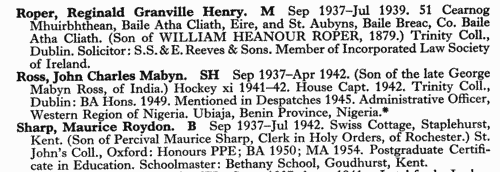
| Boys entering Marlborough College
(1910)
The public school at Marlborough in Wiltshire was founded in 1843. In 1952 this, 9th, edition of the college register was published, being a revision by L. Warwick James of the 8th edition (of 1936): but for the years before 1936 it does not merely repeat the 8th edition, because Warwick James was able to correct the 19th-century entries with information from newly-discovered letters and books from 1843 to 1853, and the school lists from 1844 onwards. The roll is arranged by year, and within each year by term of entrance, and then alphabetically by surname within each term. Each boy is assigned a number within the year: then his name is given, surname first, and, in brackets, his house. The houses within the college were called B1, B2, B3, C1, C2 and C3, and the Lower School (L Sch); the out college houses were Preshute, Priory, Cotton, Hermitage, Littlefield, Barton Hill, Summerfield and Upcot. Then there is given the boy's father's name (surname and initials) and address (at entrance), the boy's date of birth (b) and month of leaving (l). Where the boy represented the school at Rugby football (XV) or cricket (XI), in the rifle corps (VIII, or RC XI), that is indicated. There is a brief summary of achievements in later life, and, where known, and date of death or (in italics) address as in 1952. | Sample scan, click to enlarge
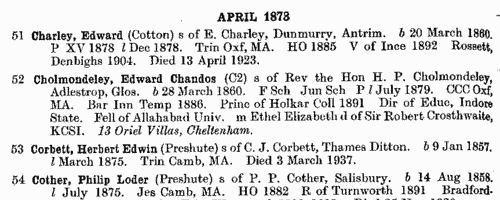
|
Research your ancestry, family history, genealogy and one-name study by direct access to original records and archives indexed by surname.
|












